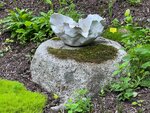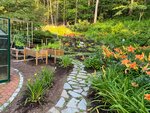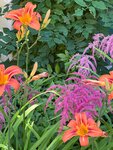


Last Spring (2022) we agreed the grass in our backyard needed to go. The mowing, raking, weeding, no longer were of interest! The lawnmower was left at the end of our driveway and was scooped up. Now the plan was real.
The entire yard, except for a third covered in lovely ivy, was covered with mulch. The idea was to create flower beds around the yard and we used mulch to define the beds. What was left was a grass path that soon became a stone path that gave a visual anchor to the new space.
We had already parsed out a section for my husband’s raised tomato and basil beds.
I took my chances with the mulch obliterating the lawn and was happily proved correct.
In 2021 I transplanted about 12 peony plants and many day lilies that had been settled in one of the older beds for many years, to another bed along our garage. We were thinking we needed the sunny peony bed for tomatoes we’d grow in bags, in addition to the raised bed we installed.
I took on the project of cutting and planting the new beds including a low rising hill to the wooded area behind our home. David took on the job of growing the tomato plants, basil, and an array of beans—the beans did not make it. The bugs came and had a feast.
We had a war of non-toxic pesticides going on until we raised our white flag and surrendered.
The tomatoes and basil, on the other hand, thrived and we had the best pesto and tomato sauce emerge from our freezer up until this past June!
As for plantings, I had a few simple requirements: they must be perennials; the heights, colors, and textures needed to vary, all needed to have that sign for “no rabbits/no deer”; and I wanted to include as many plants as possible to attract hummingbirds and butterflies.
One of the beds—a small one-- became home for a butterfly bush that was indeed a butterfly and hummingbird buffet table.
A larger bed would have bee balm, knock-out roses (one pink and one salmon),……
A long bed along our garage was enhanced with transplanted peonies and Daylilies, both of which are thriving along with astilbe.
The hill is now a mix of perennials.
A metal arbor (thank-you Amazon) was placed in a little green hallway between our home and our neighbor’s planted with daylilies and lilies, and the arbor took on a thriving honeysuckle that is a fireworks of color weaving through and around.
I found antique posts to use as a hose guide and the rusty finish keeps them in the background but interesting to look at.
A wooden bench faces the beds and is a great place to sit quietly to watch all the activity of birds, bees, hummingbirds and butterflies.
What was once a pain to mow & weed, and boring to look at, has become a tiny oasis.
Interestingly too, we have fewer pesty mosquitoes. Thank-you mulch.
Plantings from Corliss in Ipswich: Hibiscus, Crocosmia, Pink Turtlehead, Allium, Larkspur, Gaura, Knock Out Roses, Bellflowers, Bee Balm, Ligularia, English Lavender, Lamb’s Ear, Astilbe, Snowy Lanturn Enkianthus, Foxglove, Begenia, Speedwell, Pye Weed, Ajuga, Scotch Moss, Siberian Iris, Cardinal Flower (the rabbits ate them despite the belief that they don’t!)
Stone path by: DGMMasonry.com
Additional deterrents for rabbits & deer: Sprinkle cayenne pepper on leaves and hot pepper flakes around bases
Fast forward to 2023 summer. We are now in year two of the new garden.
There are lots more hungry deer and rabbits chomping on plants. Cha-ching. Cha-ching. We almost lost two new bushes to them and several plants. More cayenne pepper please!
This past winter did a number on all of the roses I planted so blooms are sketchy, and my climbers sadly have no blooms or new growth. The extreme temperatures killed some plants altogether.
But here we are, and we are hoping for the best as summer heats up.